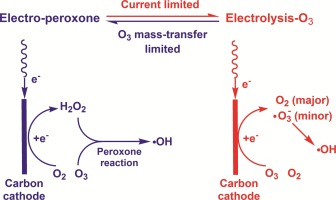Chemosphere ( IF 8.1 ) Pub Date : 2018-05-22 , DOI: 10.1016/j.chemosphere.2018.05.095 Yujue Wang , Gang Yu , Shubo Deng , Jun Huang , Bin Wang

|
The electro-peroxone (E-peroxone) process is a novel electrochemical advanced oxidation process (EAOP) that is enabled by in situ generation of hydrogen peroxide (H2O2) from cathodic oxygen reduction during ozonation. Over the past several years, the E-peroxone process has quickly emerged as a promising EAOP for the abatement of emerging contaminants (ECs) in water. Due to the enhancement of ozone (O3) transformation to hydroxyl radicals by electro-generated H2O2, the E-peroxone process can considerably enhance the efficiency and reduce the energy consumption for the abatement of ozone-resistant ECs compared to conventional ozonation. In addition, the E-peroxone process can significantly reduce bromate formation during the treatment of bromide-containing water, which has been a major concern associated with conventional ozonation for water treatment. Therefore, by simply installing electrodes in ozone reactors, the E-peroxone process can considerably improve the performance of water and wastewater treatment in many aspects. Compared with other ozone-based AOPs such as the conventional peroxone (O3/H2O2) and UV/O3 processes, the E-peroxone process also represents a more convenient, energy-efficient, and safer alternative for EC abatements. This paper reviews recent research of the E-peroxone process, with focus on the abatement of ECs in real water matrices. The fundamental reaction mechanisms that are essential to the understanding, design, and operation of the E-peroxone process are described. The abatement of various ECs in natural water and wastewater by the E-peroxone process are critically reviewed. The challenges in scaling-up the E-peroxone process and integrating it in water and wastewater treatment trains for practical applications are discussed.
中文翻译:

电-过氧化物处理工艺,用于消除新出现的污染物:机理,最新进展和前景
电过氧化物(E-peroxone)工艺是一种新型的电化学高级氧化工艺(EAOP),其通过在臭氧化过程中从阴极氧还原反应中原位生成过氧化氢(H 2 O 2)来实现。在过去的几年中,E-peroxone工艺已迅速成为一种有希望的EAOP,用于消除水中的新兴污染物(EC)。由于增加了臭氧(O 3)的电生成H 2 O 2使其转变为羟基自由基与传统的臭氧化相比,E-peroxone工艺可以显着提高效率并减少能耗,从而减少了耐臭氧的ECs。另外,E-过氧化物处理工艺可以在含溴化物的水处理过程中显着减少溴酸盐的形成,这已成为与传统的臭氧处理水处理有关的主要问题。因此,通过简单地在臭氧反应器中安装电极,E-peroxone工艺可以在许多方面显着提高水和废水处理的性能。与其他基于臭氧的AOP相比,例如常规的过氧磷(O 3 / H 2 O 2)和UV / O 3流程中,E-peroxone流程也代表了EC减排的更方便,更节能,更安全的替代方法。本文回顾了E-peroxone工艺的最新研究,重点是消除真实水基质中EC的方法。描述了基本的反应机理,对于理解,设计和操作E-peroxone工艺至关重要。E-peroxone工艺对减少天然水和废水中各种EC的方法进行了严格的审查。讨论了扩大E-peroxone工艺并将其集成到实际应用中的水和废水处理系统中所面临的挑战。















































 京公网安备 11010802027423号
京公网安备 11010802027423号